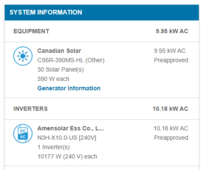Data
New Member
Hello,
I decided to get a complete hybrid system for my home.
Where to start? LOL
After getting quotes from door knockers in the mid 40k without battery backups

I checked around and found complete systems for under 20k
I guess, I still will need cables and other items and someone who installs or helps to install.
But there seems to be a long way to get up to 40k
I live in St. Lucie county Florida and FPL is my service provider.
I want a ground mount system.
I have an electrician who said he'll help me, but he needs the system plans, to look at it and give me a quote on what I want him to do.
First question. (I guess, this is step one)
I went to the FPL site and found a net metering agreement pdf to fill out.
It says :
2. Customer Qualification and Fees 2.1. Customer-owned renewable generation shall have a Gross Power Rating that: a) does not exceed 90% of the Customer’s utility distribution service rating; and b) is 10 kW AC or less. Gross Power Rating for the Customer-owned renewable generation is _________________kW AC.
What does this mean? Do I need a transformer of less than 10kw? panel total of less than 10kw? or both?
I checked some complete systems, they often come with 12kw panels etc. and 12kw or even 18kw transformer.
I found a 10kw system on bluepacificsolar so far.
Step 2.
I need to apply for owner permits.
Do I need to first buy the system, or can I get all information needed, to apply for permits first?
Step 3
Find a supplier that makes it easy to order everything I need, including 30kwh battery rack
Looking at bluepacificsolar, signature solar and currentconnected
any others I should look at?
Any help is greatly appreciated.
I decided to get a complete hybrid system for my home.
Where to start? LOL
After getting quotes from door knockers in the mid 40k without battery backups
I checked around and found complete systems for under 20k
I guess, I still will need cables and other items and someone who installs or helps to install.
But there seems to be a long way to get up to 40k
I live in St. Lucie county Florida and FPL is my service provider.
I want a ground mount system.
I have an electrician who said he'll help me, but he needs the system plans, to look at it and give me a quote on what I want him to do.
First question. (I guess, this is step one)
I went to the FPL site and found a net metering agreement pdf to fill out.
It says :
2. Customer Qualification and Fees 2.1. Customer-owned renewable generation shall have a Gross Power Rating that: a) does not exceed 90% of the Customer’s utility distribution service rating; and b) is 10 kW AC or less. Gross Power Rating for the Customer-owned renewable generation is _________________kW AC.
What does this mean? Do I need a transformer of less than 10kw? panel total of less than 10kw? or both?
I checked some complete systems, they often come with 12kw panels etc. and 12kw or even 18kw transformer.
I found a 10kw system on bluepacificsolar so far.
Step 2.
I need to apply for owner permits.
Do I need to first buy the system, or can I get all information needed, to apply for permits first?
Step 3
Find a supplier that makes it easy to order everything I need, including 30kwh battery rack
Looking at bluepacificsolar, signature solar and currentconnected
any others I should look at?
Any help is greatly appreciated.



